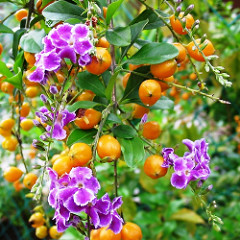Pruning, slashing, mowing, harvesting and WEEDING! A gardener will never be bored as there is always something to do when looking after land.
Weeding is inevitable in the Northern Rivers. More rain than you can poke a stick at and a mild sub-tropical climate create ideal conditions for growing everything. Ornamentals, fruit trees, veges, rainforest and other natives thrive as well as the numerous and various opportunistic plants you don’t want.
The ones some call weeds will often come by themselves and ultimately need to managed. Many we bring in ourselves, purchased from a nursery or market stall only to discover a few years later that we have introduced a problem plant or one that grows a lot bigger or spreads more dramatically than expected.
Guidelines for gardening in a rural region include: Know what you already have to start with. Work with what you’ve got. Some might need to go. Choose new plants wisely.
Duranta, aka golden dewdrop or pigeon berry, Duranta erecta or D. repens, is an attractive shrub for the garden and a popular hedge choice. Readily commercially available and not on any restricted schedule, this species however does feature in lists of environmental weeds.

This hardy bush is yet another problematic garden escapee causing damage to bushland and creek bank ecosystems. The newer cultivars marketed with trademarked names such as ‘Sheena’s Gold’ are reputed to be less weedy but it could just be a matter of time.
Originating from tropical and warm subtropical Americas, duranta has naturalised in several countries such as Philippines, China, India and Pacific Islands including Fiji, Tonga and Hawaii.
Listed in the top 50 environmental weeds in Northern NSW and Queensland, this bushy shrub is also recognised as weedy in the Northern Territory and on Norfolk Island.
Favouring creek banks, low lying paddocks and other moist areas,
duranta has also invaded both dense and open forests. It will also readily
colonise disturbed road side areas.
Growing up to six metres high in clumps almost as wide, it has graceful drooping branches. As the plant matures it develops pairs of spines along the stems. Sprays of lilac blue flowers earn it another sobriqet of sky flower. These fragrant blossoms attract butterflies. The flowers are followed by clusters of long lasting bright yellow berries. The berries are eaten by birds which spread the seeds far and wide. Note here that these berries are poisonous to many mammals and have been responsible for deaths of stock, pets and children. Garden waste dumping in bushland is another common mode of dispersal of this plant.
Plant instead natives such as lemon myrtle, Backhousia myrtifolia and lilli-pillies, Syzygium and Acmena spp instead.
Look for ways to reduce herbicide use. The world now has a huge problem with herbicide resistant weeds. Annual rye grass, originally introduced as a pasture grass for stock, interferes with grain cropping. Chemicals no longer kill it.
Around Australia 25 species of weeds have developed resistance to at least one type of herbicide. Some weeds are developing multiple resistances. Slash instead of spray. Lay cardboard under mulch around trees. Wrap black plastic over small stumps of large woody weeds to exclude light and effect a kill.
While chemical mega-companies frantically try to develop new compounds an inventive grain farmer, Ray Harrington, from WA developed the Integrated Harrington Seed
Destructor. This high speed mill device fits in the harvester and grinds the chaff including any weeds seeds to a fine pulp. The damage caused to the seeds prevents them germinating resulting in clean and mostly weed free boundless plains of grain.
Happy weeding and don’t forget the follow up.

 Follow
Follow